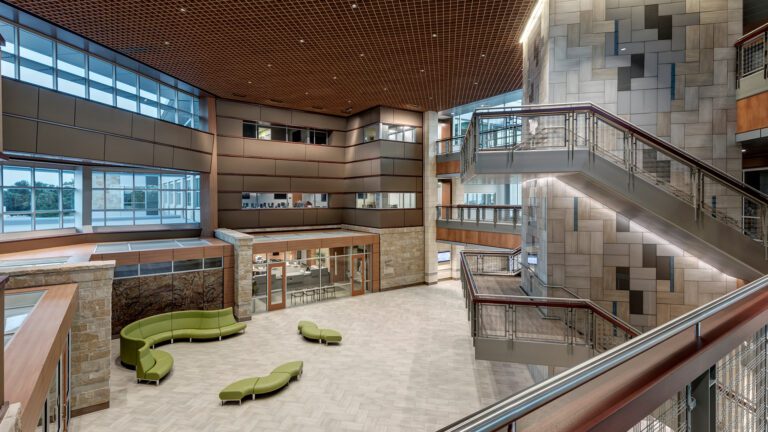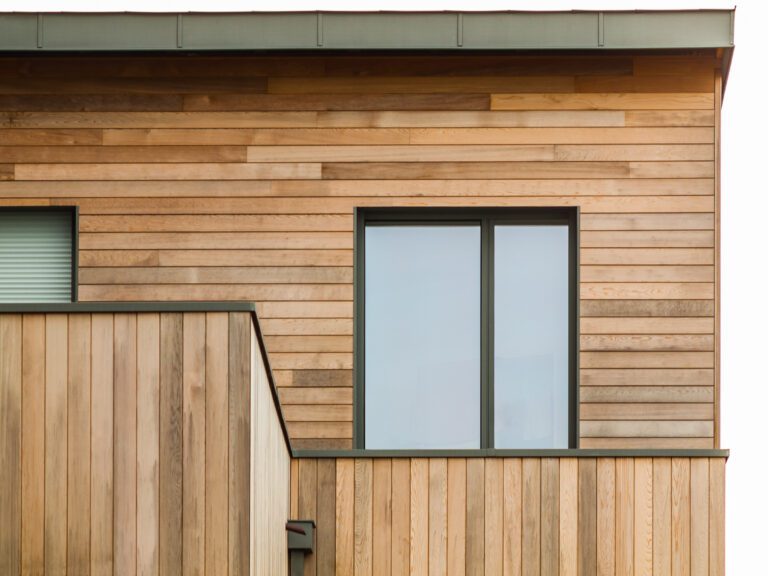What Role Do Wood Ceiling Installers Play in Commercial Projects?
The expectations for wood ceiling installers have evolved alongside modern architectural demands. No longer is the role limited to mounting panels with visual precision—installers today must understand structural compatibility, acoustics, prefabricated systems, and the nuances of working within BIM-coordinated projects. Precision is critical, as these ceilings often house lighting, HVAC, and fire suppression systems that must integrate seamlessly with design intent.
In large-scale commercial builds—such as academic buildings, healthcare facilities, and cultural venues—wood ceilings are often specified to perform both acoustically and aesthetically. Rulon offers a range of ceiling systems from Linear and Grilles to curved forms, known as Curvalon, and understanding the unique requirements of each is essential to executing clean, code-compliant installations.
Installers are key to upholding the design integrity envisioned by architects and interior designers. When properly informed and equipped, their craftsmanship bridges the gap between design concept and real-world execution. Every bracket, seam, and field modification influences not only appearance but also function—especially for acoustically treated systems.
Why Is Coordination Critical During Pre-Installation Planning?
Early coordination with the architect, general contractor, and ceiling manufacturer sets the tone for a successful installation. For wood ceiling installers, that means thoroughly reviewing shop drawings, verifying structural support, and ensuring field conditions match the specifications. Preconstruction meetings help prevent costly on-site improvisation.
Utilizing tools such as BIM models, installation manuals, and Rulon’s layout guides helps installation crews align their approach with the broader project schedule and sequencing. When logistics are tight or spaces are occupied, systems like Rulon’s Select-N-Ship offer streamlined product delivery and pre-selected kits to help teams stay on track.
Proper staging is just as important as installation. Panels should be organized and labeled to correspond with the install sequence, especially on complex ceiling geometries or phased builds. Taking the time upfront to align logistics with design coordination prevents delays and protects material integrity.
How Should Materials Be Handled to Ensure Environmental Readiness?
Wood is a responsive, organic material—making proper site conditioning and handling vital. Before installation begins, panels must be stored in a dry, conditioned space for acclimatization. Skipping this step can lead to warping, cracking, or finish degradation, particularly in environments where HVAC systems aren’t yet stabilized.
Installers should monitor site humidity levels to remain within manufacturer-recommended tolerances. For instance, Rulon’s wood ceiling systems are optimized for relative humidity between 25%–55%. Fluctuations beyond this can impact both aesthetic quality and long-term performance.
Responsible handling not only protects the product—it supports sustainability goals by reducing material waste. These efforts align with Rulon’s sustainability initiatives, which emphasize efficiency, durability, and low-impact manufacturing. Contractors who follow these protocols contribute directly to achieving those environmental benchmarks.
What Tools, Anchoring Systems, and Mounting Factors Must Be Considered?
Each wood ceiling system has its own structural and hardware requirements. Understanding anchoring methods—whether using furring channels, T-bar suspension, or direct-attach solutions—is essential to maintaining performance and safety. Improper fastening can result in deflection, system failure, or compromised acoustic value.
More intricate systems, such as Curvalon, require installers to account for the radius of each curve, substrate compatibility, and any hidden infrastructure. These panels often arrive pre-curved and pre-finished, which means accurate support framing is essential for alignment and fit.
Standard drywall tools won’t suffice. Installers should be equipped with laser levels, lift equipment, and non-abrasive handling gear. Each installation guide provided by Rulon outlines approved tools and tolerances—following these not only ensures product performance but also maintains warranty coverage.
How Are Field Modifications and Site Adjustments Managed During Installation?
Wood ceilings are not one-size-fits-all. Field adjustments are often needed—but must be approached cautiously. While minor cuts for outlet placement or lighting integration may be permitted, installers should follow manufacturer specs closely to avoid compromising acoustic performance or structural integrity.
Acoustic systems like Aluratone are especially sensitive to modification. Perforations are engineered for sound absorption, and any unplanned changes to panel layout, spacing, or backing may reduce their effectiveness. When in doubt, coordinate with the architect or Rulon’s technical team before proceeding.
Communication with the project team is essential. Installers should flag any unexpected site conditions—like framing inconsistencies or MEP conflicts—that require design clarification. Timely collaboration helps resolve issues efficiently and maintains construction momentum.
What Lessons Can Contractors Learn from Completed Wood Ceiling Projects?
Contractors who’ve worked with Rulon on high-profile projects emphasize one consistent lesson: the earlier the installer is involved, the better the result. On a recent civic project, for example, misalignment between MEP trades and ceiling framing caused a three-week delay that could’ve been avoided through pre-install coordination.
Installers noted that where close collaboration existed between design and installation teams, particularly in education builds, project handoffs were smoother and change orders were minimized. The feedback loop between shop drawing review and on-site layout proved essential in achieving both visual and performance goals.
These learnings are reflected in content developed for interior designers as well. For example, the blog Why Interior Designers Are Choosing Wood Paneling for Walls & Ceilings illustrates how installers’ understanding of panel behavior supports overall design quality. When all trades align, both design vision and construction logistics benefit.
How Do Modular Systems Streamline Complex Wood Ceiling Installations?
One way contractors are reducing risk is by selecting prefabricated modular systems. Products like Endure Direct Attach arrive ready for fast installation, with minimal field cuts and pre-engineered hardware. This reduces time on lifts, lowers error rates, and improves cost predictability.
Modular systems are especially beneficial in active environments such as schools and hospitals where ceiling work must happen during off-hours or in tight timeframes. Panels are typically labeled for sequencing, and crews can focus more on anchoring and alignment than material prep.
Installers who receive training in these systems gain a competitive edge, particularly as prefabrication continues to reshape commercial construction. Rulon’s documentation and jobsite support help ensure even complex layouts can be installed efficiently without compromising design.
What Are the Best Practices for Safety, Quality Control, and Inspections?
Safety is non-negotiable—especially during overhead work. Wood ceiling installers must follow proper lift protocols, ensure secure anchoring systems, and keep fire-rating data accessible for inspectors. Integrating panels with sprinkler heads, lights, and HVAC vents also requires precise cut-outs and code compliance.
Final walkthroughs should include punch list reviews focused on seam alignment, surface damage, and acoustic fixture integrity. It’s important to confirm that mounting hardware is concealed according to spec, especially for visible or suspended systems.
For final clarifications, installers can connect directly with Rulon’s support team. If your crew needs technical documentation, site-specific recommendations, or product details, reach out for timely assistance and expert insight.
Why Are Skilled Installers Essential to Wood Ceiling Project Success?
The success of a wood ceiling system hinges on skilled, knowledgeable installers. Their ability to interpret plans, manage variables, and coordinate with the broader team transforms raw materials into architectural features that perform under pressure.
By aligning closely with architects, designers, and suppliers, installers help protect the design vision while delivering practical, code-compliant results. Their craft supports not only aesthetics but acoustics, sustainability, and user comfort—outcomes that define modern commercial design.
For an example of how collaboration between architects and installers produces standout results, explore The Best Wood Ceiling Designs for Commercial Architects. Together, these teams build spaces that meet high-performance standards without sacrificing artistry.
How Can Strategic Partnerships Ensure Precision and Performance in Wood Ceiling Builds?
Installing wood ceilings is more than a technical task—it’s a craft that shapes the quality, function, and longevity of a space. As commercial projects grow in complexity, contractors who understand the unique demands of architectural ceiling systems bring irreplaceable value to every jobsite. Their expertise ensures that design intent is honored, materials perform to spec, and finished spaces exceed expectations.
Rulon is committed to supporting wood ceiling installers with precision-engineered systems, clear documentation, and responsive technical guidance. If you’re preparing for an upcoming installation or seeking expert input on a current build, connect with Rulon’s team to access the resources you need to deliver quality, efficiency, and impact—panel by panel.




